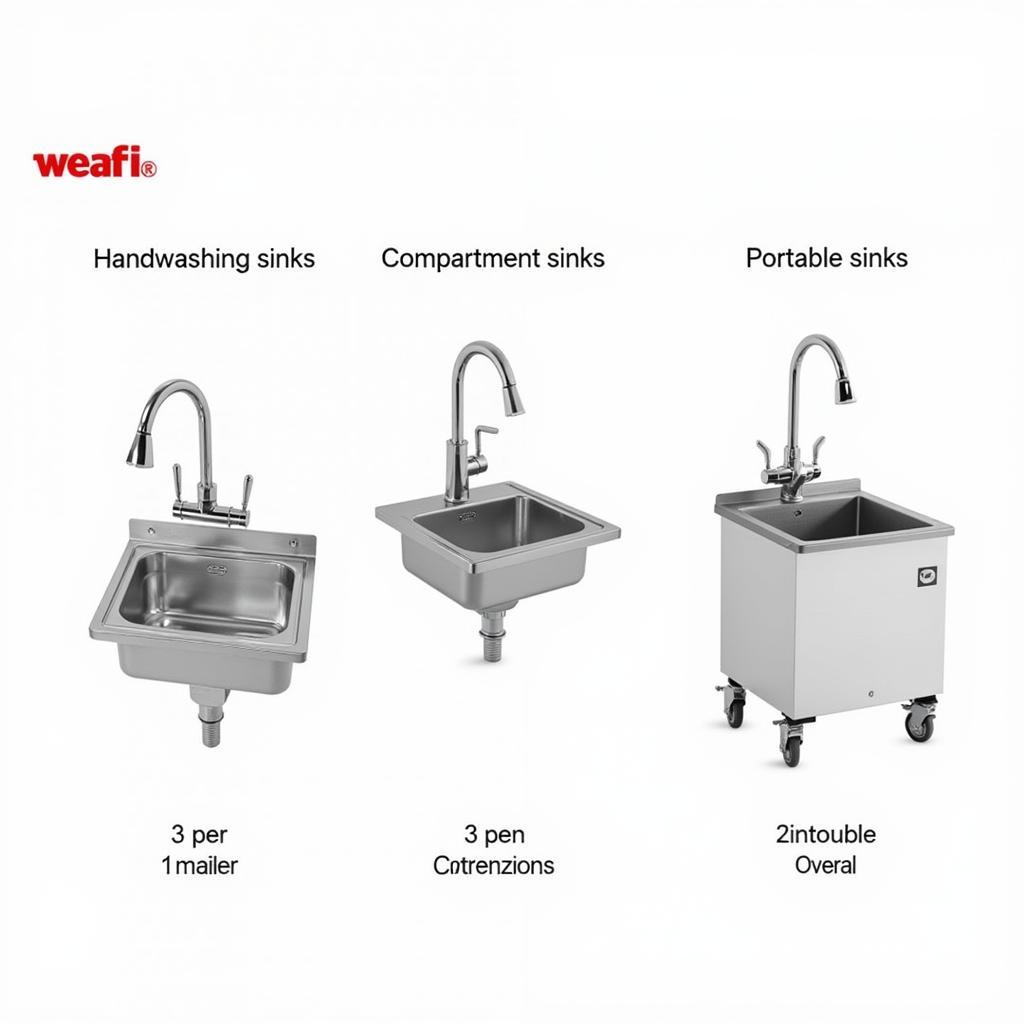Food Trailer Sinks are essential for maintaining hygiene and efficiency in your mobile food business. Choosing the right sink can make a significant difference in your workflow and ability to meet health regulations. This comprehensive guide will cover everything you need to know about food trailer sinks, from different types and sizes to installation and maintenance tips.  Different Types of Food Trailer Sinks
Different Types of Food Trailer Sinks
Types of Food Trailer Sinks
There are several types of food trailer sinks designed for different purposes:
- Handwashing Sinks: These are mandatory for hand hygiene and are typically smaller, with a single basin.
- Compartment Sinks: Ideal for washing, rinsing, and sanitizing dishes and utensils. These sinks usually have three compartments.
- Portable Sinks: A flexible solution for smaller trailers or those needing an extra handwashing station.
Choosing the right sink depends on your menu, the size of your trailer, and local health codes. For example, if you’re serving a complex menu with lots of dishes, a food trailer sink with multiple compartments is a must.
Sizing and Placement: Optimizing Your Food Trailer Space
Space is a premium in a food trailer. Selecting the right size and placement for your food prep sinks is crucial. Consider the available counter space and the flow of your kitchen operations. Measure carefully before purchasing to ensure a proper fit. A well-placed sink can significantly improve efficiency and minimize movement within the confined space.
Material Matters: Durability and Hygiene
Food trailer sinks are typically made of stainless steel due to its durability, corrosion resistance, and ease of cleaning. Look for high-grade stainless steel for longevity. While considering sinks, also consider the benefits of adding a food cart with umbrella for outdoor seating.
Why Stainless Steel is King
Stainless steel is non-porous, preventing bacteria growth and making it easy to sanitize. This is vital in a food service environment.
Installation and Plumbing: Getting Your Sink Up and Running
Proper installation is essential for preventing leaks and ensuring your sink functions correctly. Consult a qualified plumber if you’re not comfortable with plumbing work. Incorrect installation can lead to water damage and health code violations. You’ll also need to consider your grey water tank food truck capacity.
DIY vs. Professional Installation
While some handy individuals may opt for DIY installation, professional installation guarantees a proper setup and avoids potential problems.
Maintenance and Cleaning: Keeping Your Sink Sparkling
Regular cleaning and maintenance will keep your sink in top condition and prolong its lifespan. Use a mild detergent and warm water for daily cleaning. Avoid abrasive cleaners that can scratch the surface.
- Daily Cleaning: Wipe down the sink after each use.
- Weekly Cleaning: Deep clean with a specialized stainless steel cleaner.
“Maintaining a clean sink is paramount in a food trailer. It’s the first line of defense against cross-contamination,” says renowned food safety consultant, Amelia Hernandez.
Choosing the Right Faucet: Functionality and Efficiency
The faucet you choose should be practical and efficient. Consider pre-rinse sprayers for tackling stubborn food debris and touchless faucets for improved hygiene. A 20 foot food trailer might require different sink configurations than smaller trailers.
What size sink do I need for my food trailer?
The size depends on your menu and space. Larger operations need bigger sinks, while smaller menus may suffice with smaller ones.
Where should I place my food trailer sink?
Place your sink strategically for efficient workflow. Consider proximity to food prep areas and dishwashing stations.
What material is best for a food trailer sink?
Stainless steel is the ideal material due to its durability, hygiene, and ease of cleaning.
How do I install a food trailer sink?
Consult a qualified plumber for proper installation to avoid leaks and ensure compliance with regulations.
How do I clean and maintain my food trailer sink?
Regular cleaning with mild detergent and warm water, along with periodic deep cleaning, will keep your sink in optimal condition.
“Investing in a quality food trailer sink is an investment in your business. It ensures food safety, streamlines your operations, and ultimately contributes to customer satisfaction,” states experienced food truck owner, David Lee.
In conclusion, selecting the right food trailer sinks is a crucial decision for any mobile food business. By considering the factors discussed in this guide – type, size, material, installation, and maintenance – you can choose a sink that meets your specific needs and ensures a smooth and hygienic operation. Remember, a well-chosen and maintained food trailer sink is an investment in the success of your business. Don’t underestimate the importance of this seemingly small but vital component of your food trailer setup.
FAQ
- What are the different types of food trailer sinks?
- What size sink do I need for my food trailer?
- What is the best material for a food trailer sink?
- How do I install a food trailer sink?
- How do I maintain my food trailer sink?
- What type of faucet is best for a food trailer sink?
- Where can I purchase food trailer sinks?
For further information on food trailer equipment, check out our articles on food trailer sink and other related topics.
When you need assistance, please contact us by Phone: 02437655121, Email: minacones@gmail.com Or visit our address: 3PGH+8R9, ĐT70A, thôn Trung, Bắc Từ Liêm, Hà Nội, Việt Nam. We have a 24/7 customer support team.